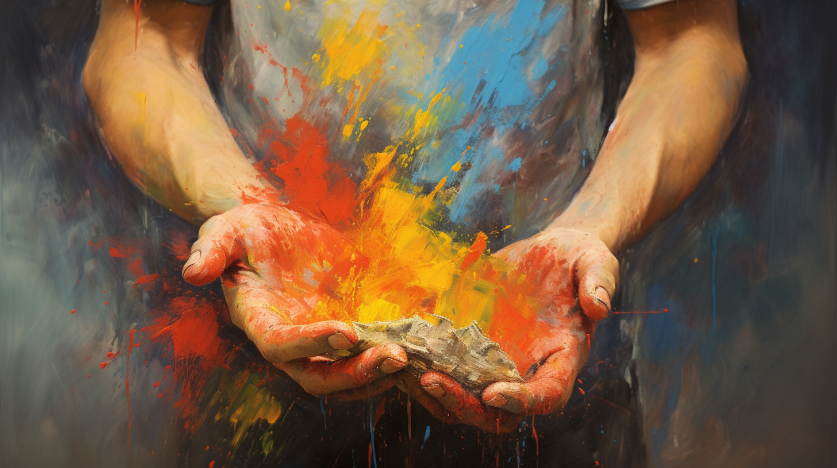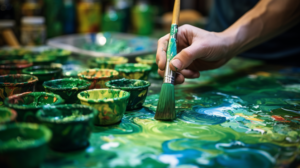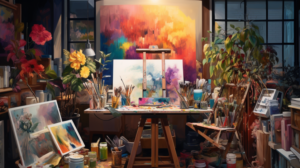
5 Essential Painting Techniques Every Beginner Artist Needs
You’re eager to bring your creative visions to life, but don’t know where to start. Don’t fret! We’re here to help you master the art of painting.
From color theory and brushwork basics to advanced techniques like glazing and scumbling, we’ve got it covered. Let’s not forget the magic of palette knife painting too.
So, grab your brushes, roll up your sleeves, and let’s dive into these five essential painting techniques every beginner artist needs.
Understanding Color Theory
Your understanding of color theory is crucial to creating vibrant, engaging works of art. Color wheel exploration is your first step. It’s not just about knowing primary colors, but also their interactions, complementary hues, and the resulting secondary and tertiary colors. This wheel is your guide to blending and contrasting colors effectively.
Simultaneously, it’s important to grasp tonal values understanding. It’s about recognizing the brightness or darkness of a color. In a painting, tonal values create depth, bringing a three-dimensional feel to a two-dimensional canvas.
Mastering color theory isn’t merely learning the basics, it’s an ongoing process. Be patient and persistent. Practice with purpose, experiment with courage. With time, you’ll witness your art transform, becoming more compelling and visually striking.
Mastering Brushwork Basics
Once you’ve got a handle on color theory, the next crucial step in your painting journey involves mastering the basics of brushwork. Understanding brushwork is much like learning a new language, each stroke tells a different tale. So, let’s start with brush selection tips. The right brush can make a world of difference. For details, use a small, pointed brush; for large areas, a flat, wide one.
Now, onto brush cleaning methods. Never let paint dry on your brush, it’s a cardinal sin in painting. Rinse your brushes thoroughly in water for acrylics, and in solvent for oils. Gentle soap can be used for deep cleaning. A clean brush will give you the precision and smoothness your artwork deserves.
Grasping the Glazing Technique
After mastering brushwork, it’s time for you to delve into the glazing technique, a method that can add depth and luminosity to your art. This method involves applying a thin, transparent layer of paint over a dry, existing layer.
Glazing material selection is crucial here; typically, oil paints are used due to their transparency. However, acrylics can also be used with glazing mediums to achieve the desired effect.
The impact on texture is profound. Glazing doesn’t just change the color; it adds a richness and depth that’s hard to achieve with a single layer of paint. It can smooth out rough textures, or enhance them, depending on your goals.
Exploring the Scumbling Method
While you’re gaining confidence with the glazing technique, it’s time to start exploring another essential method called scumbling.
In contrast to glazing, scumbling involves applying a thin layer of opaque or semi-opaque paint over a dry base layer to create depth, texture, and subtle color variations.
Scumbling in portraiture, for instance, is often used to enhance the realistic effect of skin tones and facial features. It’s a technique that requires a delicate touch and a keen eye for detail.
On the other hand, abstract scumbling applications allow for a more dramatic and expressive use of the method, as it can bring an exciting dynamic quality to your pieces.
Perfecting Palette Knife Painting
Now that you’ve dipped your brush into the scumbling method, let’s shift your artist’s focus to perfecting another vital skill: palette knife painting.
This technique allows you to apply paint directly onto the canvas, creating texture and depth that a brush can’t achieve. Your palette knife selection is crucial; choose a flexible, sharp-edged tool for precision. The knife’s shape impacts the strokes you can create, so consider the style you aim for before purchasing.
Remember, knife maintenance tips are equally important. After each use, clean the blade thoroughly with a cloth and mild soap. Ensure it’s dry to prevent rust.
Practice is key to mastering this technique; with time, you’ll create vibrant, impactful pieces.
Frequently Asked Questions
What Are Some Recommended Exercises to Improve My Drawing Skills Before I Start Painting?
To improve your drawing skills, focus on sketching basics like shapes and lines. Regularly practice perspective drawing to capture depth. Draw from life often, it’ll enhance your observational skills before you transition to painting.
How Can I Maintain and Clean My Painting Tools Properly?
To maintain and clean your painting tools properly, adopt good tool storage solutions. Clean brushes immediately after use, store paints airtight, and respect material’s lifespan. Proper care ensures tools perform their best, longer.
Are There Any Specific Types of Paints That Are Best for Beginners?
Absolutely, as a beginner, you’ll find acrylics and watercolors quite forgiving. Understanding acrylics is easy, they’re versatile and dry quickly. Exploring watercolors is also a must, providing a soft, fluid style to your art.
How Do I Decide on the Size and Type of Canvas for My Painting?
Choosing your canvas size and type depends on several Canvas Selection Factors. Consider your painting’s purpose, space, and style. Explore Canvas Material Varieties like cotton or linen to see what suits your style best.
What Are Some Tips for Effectively Mixing and Blending Colors?
When mixing and blending colors, understanding color theory basics is key. You’ll need to manage your palette effectively. Start with primary colors and gradually mix to achieve desired shades. Practice makes perfect, don’t rush.
You’ve now got the basics down: color theory, brushwork, glazing, scumbling, and palette knife painting. Keep practicing these essential techniques and you’ll see your artistry flourish.
Art is a journey, not a destination, so enjoy every stroke and color mix. Remember, it’s your interpretation and creative perspective that makes every piece unique.
So, grab your brushes and let your canvas reflect your artistic vision.
Happy painting!


